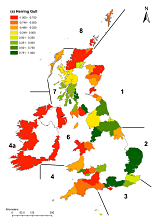DECLINES IN GULLS, A CONSERVATION CONUNDRUM
Published: 6 July 2016
Gulls have increasingly become a familiar sight in cities, in particular in the UK over recent years. While some welcome watching beautiful wildlife at their doorstep, others are concerned about the possible nuisance the urban gulls may cause. But why have gulls increased in our cities? Most people probably don't realise that despite having become such a familiar sight in cities, these same gull species have actually shown dramatic declines in their natural habitat.
Some of the declines were of such an extent that it turned a species that has been treated as a problem species that needs to be controlled into a species of conservation concern. Here we also have a species whose presence in towns indicates troubles in the sea of which they depend and act as a vocal witness for many other seabird species that silently decline in numbers without most of us noticing it.
The question is why have some gull species declined in the natural habitat but increased in cities? This is a difficult question to answer. First, we need to know how their populations have changed nationally over time. Fortunately we have three good surveys in the UK between 1970 and 2000 that can give us a good idea how numbers have changed in the last three decades of the last century. Here we have looked at the three species of large gulls that occur on the British Isles. Interestingly all three species showed different trends: Herring Gull, Lesser Black-backed Gull and Great Black-backed Gull. Herring Gulls declined by 57%, whereas Lesser Black-backed Gulls increased by 82% and Great Black-backed Gull numbers tended to decline by 10% but that was not statistically significant. There is no comprehensive nationwide since 2000, but indices from representative colonies that were counted indicate that in the first decade of the 21st century all three species declined in numbers dropped by 3 - 5% per year.

It is interesting that despite a similar general ecology the species have shown so different population trends between 1970-2000. Because during that period the whole of the British Isles was covered we can also look whether changes had been different in different parts of the British Isles which can give some insights into possible causes of the decline. While the trends were similar across the whole British Isles in Lesser and Great Black-backed Gulls, the pattern for the Herring Gull, the species that most declined, is very interesting. The species declined very strongly in their former strongholds in the West and the North while they held their numbers or even increased where they used to be rare (see the Map below). And it is not only that they shifted their distribution geographically they have also increased in built-up areas. Herring Gull numbers in built-up areas increased most strongly in regions where their numbers in the natural habitat dropped most. This possibly suggests that they seek cities as a refuge from deteriorating conditions in their traditional coastal habitats. The increases in built-up areas, however, were by an order of magnitude smaller than the losses in the natural habitat. However, it is worth noting that counting gulls nesting in urban environments is difficult and possibly their numbers are underestimated.

Herring Gulls also showed density-dependent changes in population size with strongest declines where numbers are highest, but that was no found in the other two species. Density-dependent effects may mean local prey depletion or that larger groups are more susceptible to intra-species interactions (cannibalism, disease), and that Herring Gulls are more susceptible to such effects than the other species. In another species-difference, compared to Herring Gulls, Lesser Black-backed Gulls expanded their range into the urban environment, so that where numbers in natural habitats increased their numbers in urban habitat also increased.
Although this does not tell us what caused the decline in gulls, the different patterns between species and populations within then Herring Gulls indicate that there is no one single cause affecting all gulls. So the usual suspects of changes in fishery activities, use of landfill sites and disturbance at colonies (e.g. culling for reasons of public health or conservation) cannot provide a simple explanation of the observed patterns. Instead most likely more subtle changes in their main foraging habitat, the intertidal zone, to which the different species respond differently are a likely explanation and that locally relevant factors and local competition are involved.
Large declines in hitherto abundant species create a dilemma for conservation bodies in prioritising conservation policies. Large declines of an hitherto abundant species has taken many people by surprise and now clearly marks this species as one of high conservation concern while it was formerly treated as a pest species. Differences in population trend between species and within species between regions suggests there is no single cause for all species and all of British Isles - requires species and region-specific conservation management strategies.
First published: 6 July 2016

